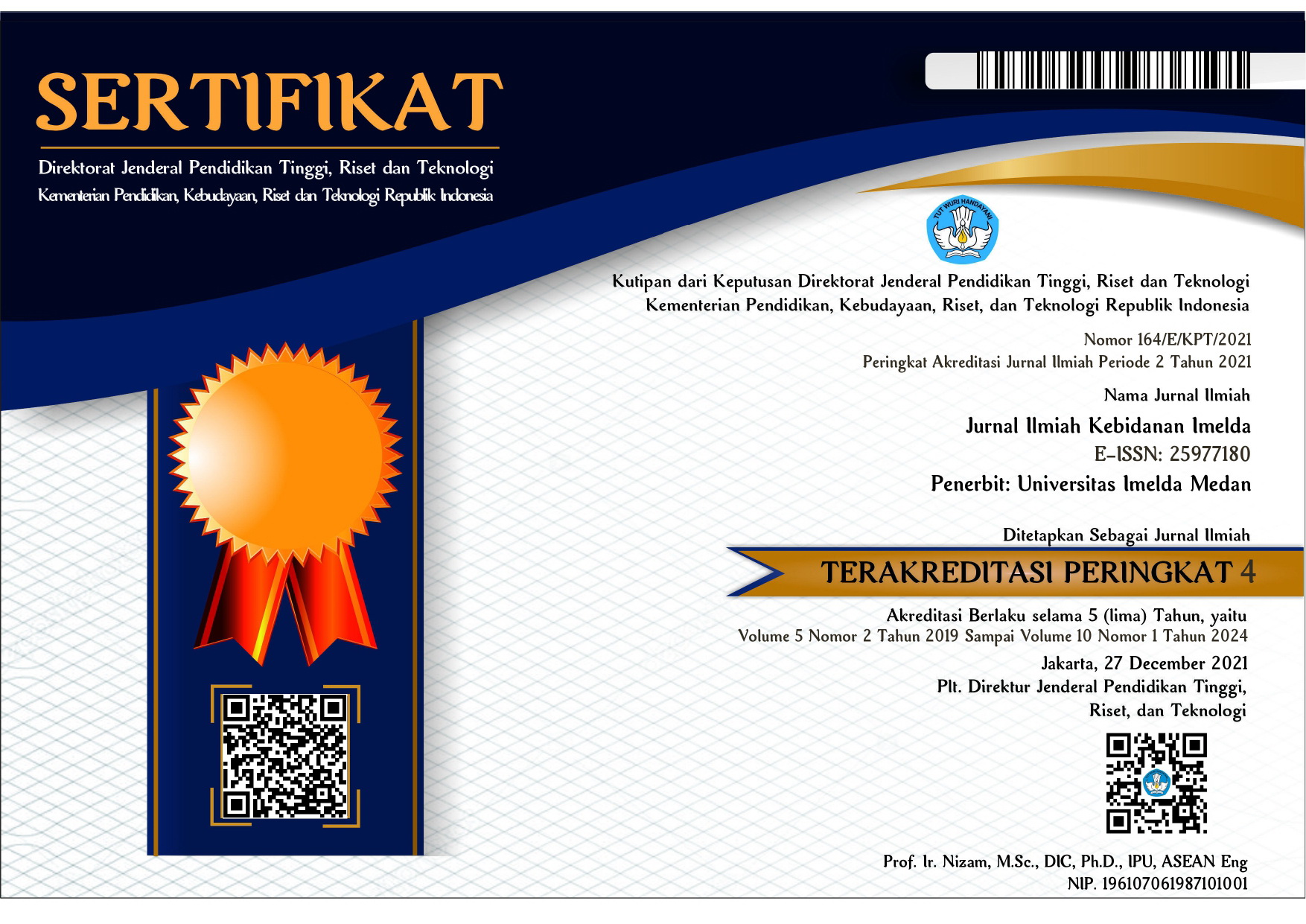PENGARUH PEMBERIAN JUICE KACANG HIJAU TERHADAP PENINGKATAN PRODUKSI ASI IBU NIFAS
DOI:
https://doi.org/10.52943/jikebi.v9i2.1372Abstract
Introduction: Mother's Milk (ASI) is the single most perfect food for babies in the first 6 months of growth, without any additional drinks or food. The low level of exclusive breastfeeding is caused by problems that are often caused by breastfeeding mothers, namely milk production that is not optimal. One of the factors that can affect milk production is the nutrition of breastfeeding mothers. Phaseolus radiatus is a food ingredient that can stimulate milk production. Objective: to determine the effect of giving green bean juice on milk production in postpartum mothers. Methods: This research is a quantitative research with a quasi-experimental method with a one group pretest posttest research design. The population of postpartum mothers at the Kebondalem Health Center, Pemalang Regency, with a total of 30 postpartum mothers using accidental sampling technique, totaled 16 samples of postpartum mothers. Data analysis used the Wilcoxon test with a ? value of 0.005 or asym.sig <0.05. Results: the average postpartum mother has doubled her milk production before and after consuming green bean juice regularly for 3 days.Conclusion: There is an effect of giving green bean juice to increase milk production in postpartum mothers.
References
2) Pusat Kajian Anggaran Badan Keahlian DPR RI. 2021. Dak fisik bidang kesehatan dalam mendukung target penurunan angka kematian ibu (AKI) dan anak (AKB).
3) Helda. Kebijakan Peningkatan Pemberian ASI Eksklusif. Jurnal Kesehatan Masyarakat Nasional Vol. 3, No. 5, April 2019
4) Kemenkes. 2017. Profil Kesehatan Indonesia Tahun 2016. Jakarta: Kementrian Kesehatan RI.
5) Simamora, M.F. 2015. Hubungan Perawatan Payudara dan Kebiasaan Makan dengan Kelancaran Produksi ASI pada Ibu Nifas di Wilayah Kerja Puskesmas Matiti Kecamatan Doloksanggul Kabupaten Humbang Hasundutan. Skripsi. Fakultas Kesehatan Masyarakat Universitas Sumatera Utara Medan.
6) Kementrian Kesehatan Republik Indonesia. 2017. Profil Kesehatan Indonesia 2016. Jakarta : Kementrian Kesehatan Republik Indonesia
7) https://www. Badan Pusat Statistik.go.id/indicator/30/1340/1/ persentase bayi usia kurang dari 6 bulan yang mendapatkan ASI Eksklusif.html. diunduh tanggal 15 Juli 2022
8) Dinas Kesehatan Prov. Jateng. 2020. Profil Kesehatan Provinsi Jawa Tengah Tahun 2019. Semarang: Dinkes. Prov. Jateng.
9) Dinas Kesehatan Kab. Pemalang. 2022.Cakupan ASI Eksklusif.
10) Iriani, F. 2017. Pengaruh Pemberian Sari Kacang Hijau (Vigna Radiata) terhadap Kelancaran Produksi ASI Ibu Postpartum di Wilayah Kerja Puskesmas Pelambuan Banjarmasin Tahun 2017. Manuskrip. Universitas Muhammadiyah Banjarmasin
11) Elika, Puspitasari. 2018. Pengaruh Pemberian Susu Kedelai Terhadap
Peningkatan Produksi ASI Pada Ibu Nifas di RB Bina Sehat Bantul. Jurnal Kebidanan, 7 (1), 2018, 54-60.
12) Nikmah jalilah ritonga, eka defi mulyani, diah evawanna anuhgera, damayanti, riris sitorus, wilda Wahyuni siregar. Sari kacang hijau sebagai alternatif meningkatkan produksi air susu ibu (asi) pada ibu menyusui. Jurnal Keperawatan dan Fisioterapi (JKF), Vol. 2 No.1 Edisi Mei-Oktober 2019.
13) Nani, J., & Tiara, Z. (2021). Pengaruh Sari Kacang Hijau Terhadap Peningkatan Produksi Asi Di Klinik H.Syahruddin Tanjung Balai. Jurnal Stikes, 3(2), 62–66
14) Suksesty, C.E. 2017. Pengaruh Jus Campuran Kacang Hijau Terhadap Peningkatan Hormon Prolaktin dan Berat Badan Bayi di Bidan Praktik Mandiri (BPM) Kecamatan Neglasari Kota Tangerang. Jurnal Ilmiah Bidan, Vol.II, No.3, 2017. Universitas Muhammadiyah Tangerang
15) Zilfi,Yola, Pitri., Adiva,Syafira, Arla. Pengaruh bubur kacang hijau terhadap kecukupan Air Susu Ibu (ASI) setelah melahirkan. Jurnal Indragiri Penelitian Multidisiplin 2023;Vol. 3, No. 1.










